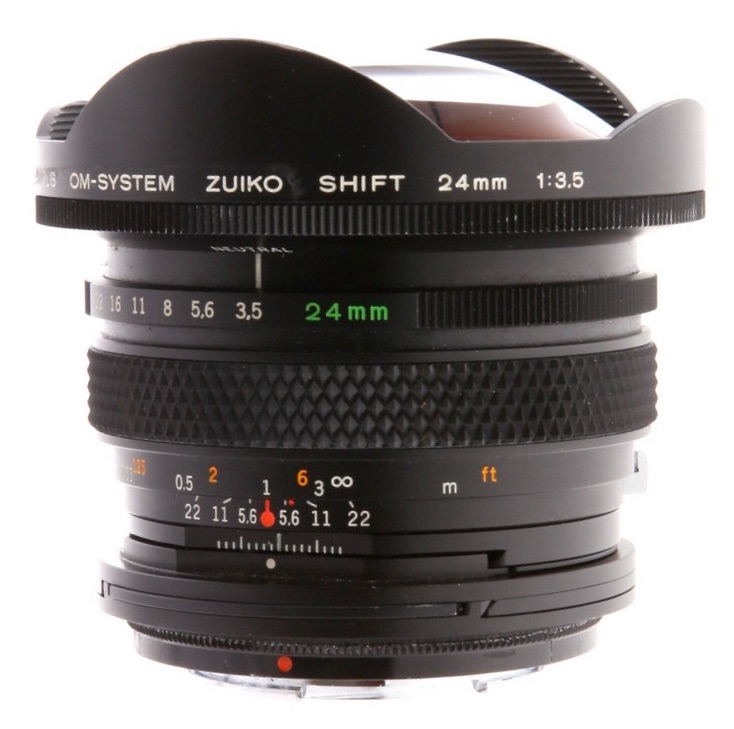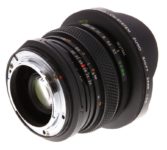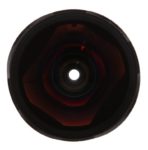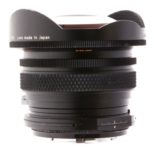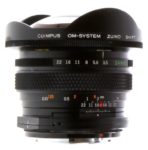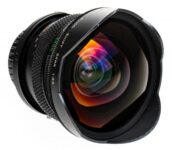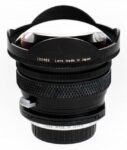Olympus OM Zuiko 24mm F/3.5 Shift
Shift lens • Film era • Discontinued
- Announced:
- · 1983
- Production status:
- ● Discontinued
- Country of design:
- · Japan
- Original name:
- · OLYMPUS OM-SYSTEM ZUIKO SHIFT 24mm 1:3.5
- Class:
- · Slow full-frame shift lens
- · Professional model (Top class)
- System:
- · Olympus OM (1972)
Abbreviations
| SHIFT | Perspective Control. |
Specification
| Optical design: | |
| 35mm full frame | |
| 24mm | |
| F/3.5 | |
| 12 elements in 10 groups | |
| 1 ED | |
| Internal focusing (IF) | |
| Olympus OM [46mm] | |
| 84° (35mm full frame) | |
| Diaphragm mechanism: | |
Diaphragm type: | Manual |
Aperture control: | Aperture ring |
| 6 (six) | |
| Focusing: | |
| 0.35m | |
| <No data> | |
Focusing modes: | Manual focus only |
Manual focus control: | Focusing ring |
| Perspective control mechanism: | |
Shift range: | -10..0..+10mm |
Tilt range: | Not available |
| - | |
| - | |
| Physical characteristics: | |
| 510g | |
| ⌀84×75mm | |
| Accessories: | |
| Removable front filters are not accepted | |
| Built-in L39, Y48, O56, R60 (part of the lens optical system) | |
| Built-in petal-shaped | |
| Not compatible |
Sources of data
- Manufacturer's technical data.
- The Zuiko Interchangeable Lens Group booklet.
- Olympus OM-4 booklet (November 1983).
- Olympus OM system booklet (December 1985).
- Olympus OM-4T booklet (August 1986).
Manufacturer description #1
This is the world's first super wideangle shift lens which ensures excellent resolution by using a special low-diffusion glass. It also provides an inner focus system with the lens' overall length unchanged and built-in filters, thus promising high maneuverability.
Manufacturer description #2
Another astounding OLYMPUS achievement: the world's first super wide-angle shift lens, with a maximum picture angle of 100°. For architectural photography in today's high-rise cityscapes, or for distortion-free interiors, this lens is irreplaceable. It adopts extra low distortion glass for the front lens element, and minimizes chromatic aberration to assure excellent peripheral resolution.
From the Modern Photography magazine (January 1985)
Perspective control (better known as PC) lenses have been around for a long time, but this one allows the user to move the lens up to 10mm off the optical axis without appreciable loss of sharpness or fall-off in illumination despite its ultrawide length and relatively wide f/3.5 aperture. To achieve this requires the lens to cover a 57mm circle - an angle of view of about 100°, so the Olympus' 24mm Shift uses 12 elements in 10 groups, one of which is a deeply curved 72mm front element reminiscent of a fish-eye lens. At first glance, its optical construction looks like that of a fish-eye, yet the lens shows a low 1.09% barrel distortion. Light fall-off at the extreme edges of the image in full shift position is a measured 2.3 stops. In actual field tests, however, it is barely noticeable, even at the extreme off-axis position.
Because of its wide angle of view and high speed, front-mounted filters and attachments cannot be fitted. Instead, the 24mm PC has a rotating, click-stopped filter wheel positioning neutral, Y48 yellow, O56 orange and R60 red filters within the barrel of the lens.
Although the rear cell of the lens is easily accessible, it is unthreaded. With some ingenuity, it could be adopted to take small screw-in auxiliary filters or gelatine cut-outs.
The lens is lightweight and well-balanced in spite of its impressive size and is easy to handle in all respects. Like its older but more conservative brother, the Zuiko 35 Shift, the 24 has a bottom-mounted diaphragm stop-down lever. Push it in and the lens stops down for shooting. Push again, and it opens up for focusing and viewing - a commendable convenience but you must keep your wits about you when changing lenses rapidly lest you forget that you've now mounted a lens without an automatic diaphragm. If your Olympus SLR is in aperture-preferred auto-exposure mode, a glance at the shutter speed indicator should remind you. However, in manual mode, it is recommended that you read your set aperture with the lens centered, and then shift. Also, in automatic mode, the exposure indicated in the finder may not be correct when the lens is shifted but the exposure on film proved to be quite accurate when using Olympus models which read off the film plane (e.g. the OM-2, OM-2 S program, and OM-4).
Controls, from front to rear are as follows: A thin 1/8 in. wide knurled filter setting ring clicks into position (make sure it does as intermediate position, will blend filter effects unpredictably). Next, a 3/32 in. wide aperture ring sets white engraved f/stops opposite a white indicator. A 3/4 in. in wide Olympus diamond patterned rubber focusing grip comes next. Footage scales are in gold, meters in white, and white depth of field indicators engraved for every other f/stop. Engraved, white millimeter scales with central indicators and click stops indicate the degree of sideways shift and vertical rise or fall. No creep was found on either setting, a tribute to the effective oil damping of the twin dove-tail soiders. Mechanical stops on both movements keep you from exceeding the lens' coverage in any direction. In practice, you just look through the finder and move the lens whichever way you want with your focusing hand. It's very fast and easy to use. The lens close-focuses to 15 in. without changing length - the focusing mechanism is internal.
All in all, this is a lens to gladden the heart of any architectural photographer working in confined spaces inside or out. And the optical quality is remarkably good for a lens of this type.
Other shift lenses in the Olympus OM system
| ■Olympus OM mount (1) | |||||||||
| Olympus OM Zuiko 35mm F/2.8 Shift | M | 8 - 7 | 0.30m | ⌀49 | 1972 ● | ||||
